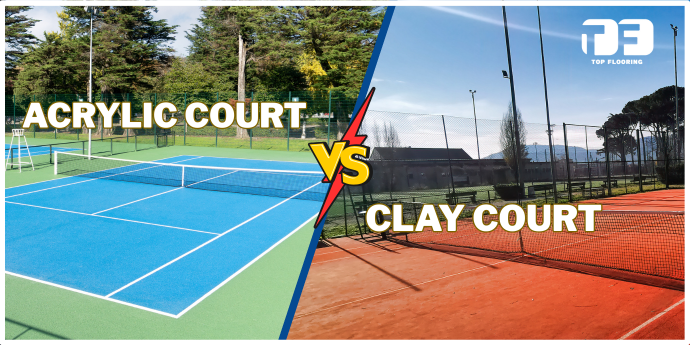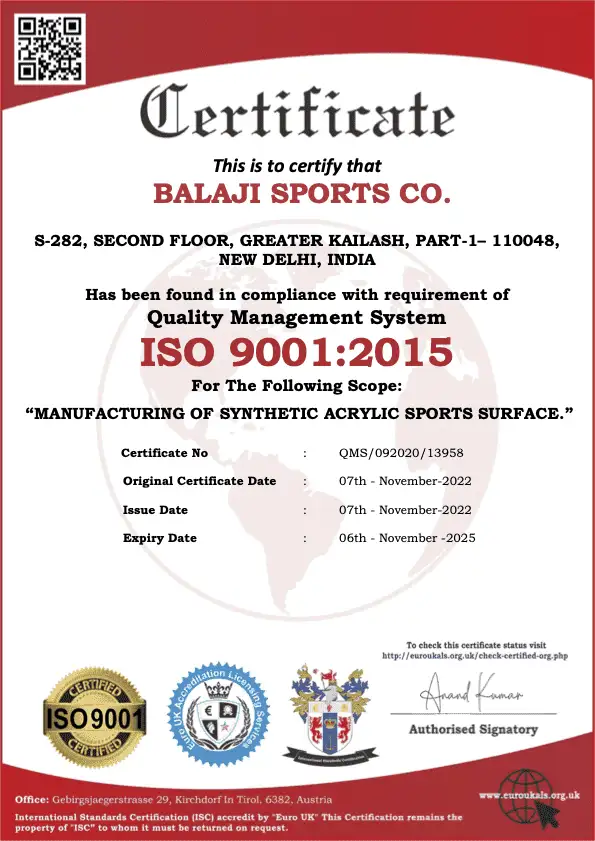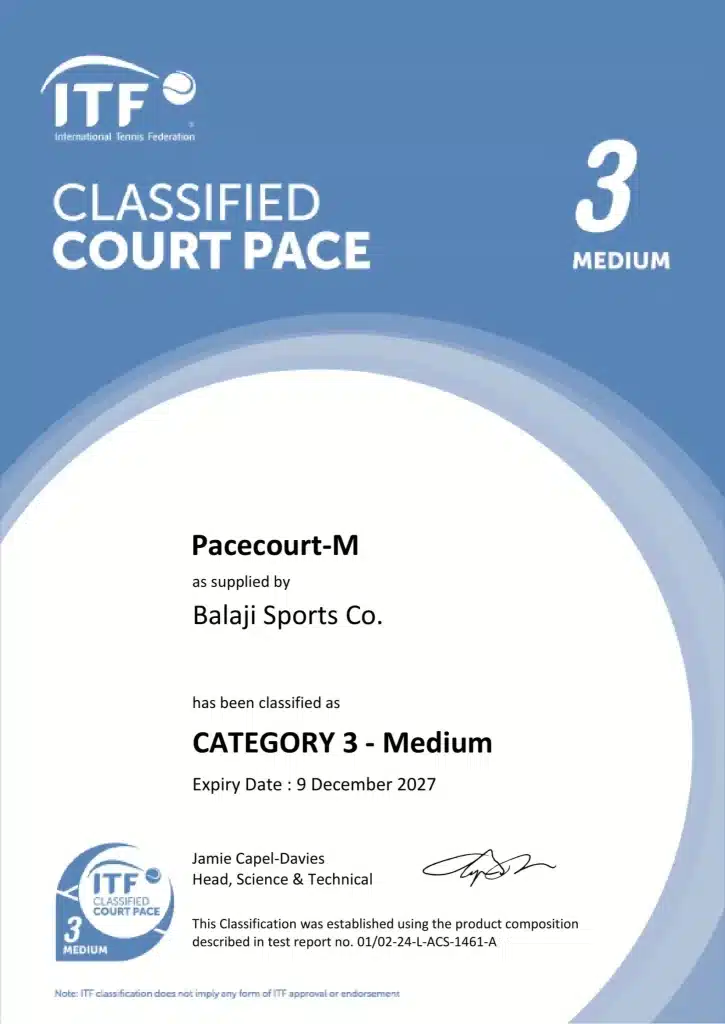A durable tennis court is only possible when the base is strong. While the colorful acrylic top layers are what players see and feel underfoot. It’s the hidden base foundation that carries the weight. This base supports the entire surface system, whether it is a concrete or asphalt tennis court construction. Which absorbs the constant pounding of running, sliding and ball strikes and determines how well your tennis court flooring holds up to years of play. A good base is like the backbone of a tennis court flooring. It keeps the surface level and crack free, drains water after rain and resists temperature swings.
If the base fails, even the best quality acrylic coatings or synthetic sports flooring won’t last long. Cracks, uneven bounce, puddling and premature surface wear are almost always the result of a poor base not the surface paint. That’s why professional sports flooring contractors always say get the base right the first time. For example, asphalt is more flexible and budget friendly so it’s often used for backyard tennis court construction and community level projects. Concrete is more structural and long lasting so it’s used for high traffic tennis academies, clubs and sports complexes. Understanding these differences is key especially when considering the cost of a tennis court and planning for future resurfacing cycles.
Tennis Court Base Construction
Players often see the colored acrylic tennis surface on top but the strength and stability of a tennis court comes from the base. This base is the structural base that carries the entire load of the tennis court surface system, players movements and weather stress over many years.
How to Build Tennis Court Base
- Base Preparation: The first step in tennis court construction is base preparation which is the soil layer at the site. This soil is arranged to a level surface and then compacted using heavy rollers to make it stable. Any soft or loose patches are removed or replaced with stronger soil or stone fill.
- Base layer installation: Once the preparation is stable the structural base is installed this is usually made from either asphalt or concrete. This layer gives the tennis court its strength, hardness and slope for drainage.
- Acrylic surfacing system: This includes a primer, an acrylic resurfacer to smooth out the surface, optional cushion coats for player comfort, color coats to give the court its vibrant appearance and finally white line markings for gameplay.
Why Tennis Court Base Matters
The base layer is the most critical structural component of a tennis court. It decides how well the upper layers bond, how water drains off and how the surface responds to daily play. A properly built base stays smooth, stable and crack free for decades. While a weak or uneven base can cause even the best acrylic layers to bubble, crack or peel prematurely. In short the long term performance and life of your tennis court depends almost entirely on the quality of its base construction.
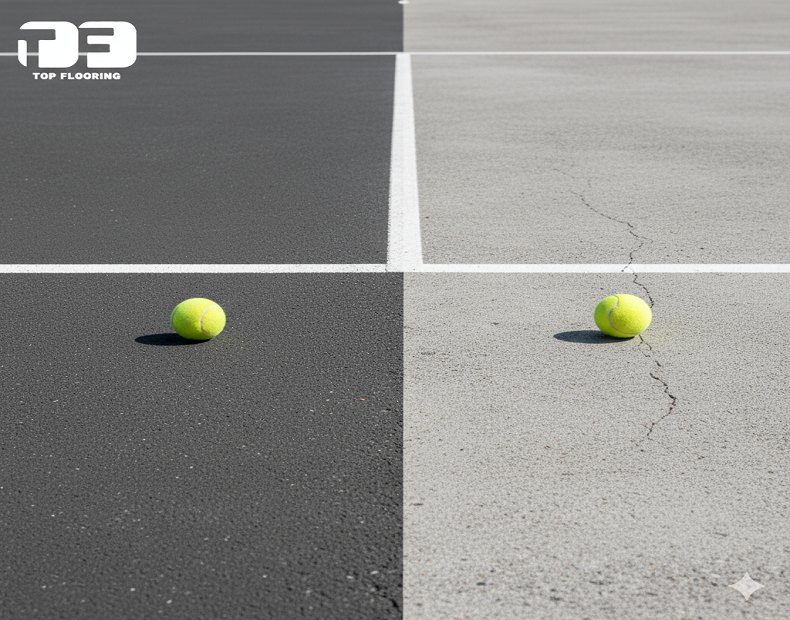
Asphalt Tennis Court Construction
Asphalt has been the traditional choice for tennis court bases for decades, especially for outdoor courts. Affordable and slightly shock absorbing, it has been the go to option for schools, clubs and housing societies looking to build durable playing surfaces. Its popularity stems from the fact that it strikes a balance between performance and cost, making it a preferred tennis hard court material in many regions.
How Asphalt Courts Are Built
- Hot mix asphalt is delivered to the site and laid over a compacted stone sub-base.
The construction process starts with thorough ground preparation, where the base is leveled and compacted. A crushed stone layer is added to provide drainage and stability. - It’s rolled to achieve court thickness, once laid heavy rollers are used to compact the asphalt. This step is crucial to remove air pockets and create a strong, dense layer that will not shift or sink over time.
- After curing, acrylic surfacing is applied on top, after the asphalt has cured for a few weeks, the tennis court is finished with a multi-layer acrylic tennis court construction system. This includes layers of acrylic resurfacer, cushion coats, color coats and finally, precision line markings.
Advantages of Asphalt Bases
- Lower cost: One of the biggest reasons people choose asphalt is its affordability. Asphalt is much cheaper to install than concrete, which makes it ideal for projects that need to stay within tight budgets.
- Shock absorption: Asphalt’s slight flexibility gives it a natural cushioning effect. This makes it softer on players’ joints and helps reduce exhaustion during long matches.
- Fast installation: Another big plus is speed. Asphalt tennis courts can be laid and surfaced much quicker than concrete tennis courts as asphalt sets fast.
- Widely available: Skilled asphalt cover teams are everywhere. So it’s easy to find qualified people to do asphalt tennis court construction without the delays that come with specialized concrete work.
Disadvantages of Asphalt Courts
- Shorter lifespan: Asphalt is affordable but doesn’t last as long as concrete. A typical asphalt tennis court has a lifespan of 10–15 years before major resurfacing or repairs are needed.
- Cracking: Asphalt expands in heat and contracts in cold weather. This constant movement can cause small cracks to form which can grow bigger if not repaired soon.
- Weather sensitive: Asphalt doesn’t like extreme weather. High heat can soften the surface and standing water can seep in and cause deformation and potholes.
- Maintenance: Because of its tendency to crack and weather, asphalt tennis courts require more maintenance. Regular crack filling, patching and periodic resurfacing is essential to keep the surface safe and playable.
Asphalt Tennis Courts Cost
- In India, the cost of a tennis court with an asphalt base typically includes earthwork, base preparation, acrylic surfacing, fencing and lighting. But actual prices depending on site conditions and design choices.
- If you are wondering how much does a tennis court cost to build or price to build a tennis court. Asphalt is a relatively affordable starting point. It allows schools, housing societies and clubs to have a functional tennis court without the higher upfront investment of concrete.
- If you are planning asphalt tennis court construction in your backyard. The cost may be lower as the site is smaller and simpler. But don’t forget to factor in additional elements like excavation, grading, fencing, drainage and the acrylic tennis court construction system that will go on top.
Concrete Tennis Court Construction
Concrete has become the modern choice for tennis court base construction. It’s chosen for stability, strength and longevity. Unlike asphalt which can soften and crack under extreme weather, concrete creates a hard base that stands up to decades of use with minimal damage. It’s perfect for academies, housing societies and sports facilities looking for a long term investment.
How Concrete Courts are built
- The construction of a concrete tennis court starts with a compacted stone sub-base to ensure proper drainage and load distribution. On top of this base reinforced concrete is poured in uniform thickness usually 100-125mm to form the main structural slab of the court.
- These joints absorb any natural heating and contraction that happens with temperature changes.
- Once it’s done a multi layer acrylic surfacing system is applied on top to create the final tennis playing surface with the right bounce, grip and aesthetics.
Advantages of Concrete Bases
- Durability: One of the biggest advantages of concrete is its ability to last. Properly constructed concrete tennis courts can last 25-30 years or more with very little structural damage.
- Stability: It’s far less open to expansion and contraction with temperature changes than asphalt which moves significantly in extreme heat or cold.
- Cracking: The few cracks that appear are normal and easy to maintain. This means players have a smooth and even surface throughout the court’s life.*
- Less maintenance: Although the cost is higher concrete courts need less repairs and resurfacing over 20-30 years.
Disadvantages of Concrete Courts
- Higher cost: The biggest disadvantage is the higher investment. Concrete requires more material, steel reinforcement and labor than asphalt so it’s expensive to install.
- Harder surface: Concrete provides a much harder playing surface with lower natural shock absorption. While this gives better ball speed and bounce consistency, players joints, regular players or older players.
- Longer curing time: A concrete slab needs at least 30 days of curing before applying the acrylic layers. This extended the overall project timeline compared to asphalt tennis courts which can be surfaced within days of paving.
- Contractors required: Building a concrete tennis base requires more workmanship and expertise. Proper installation of joints, leveling and curing is critical to stop future issues. So hiring experienced sports infrastructure contractors is important.
Cost of Concrete Tennis Courts
- The cost to build a tennis court in your backyard using concrete is depending on site conditions, design, joint spacing, drainage system, curing time and surface finishing.
- Concrete courts last much longer and need less repairs, their cost is much lower. Owners avoid crack filling, patching and base reconstruction that asphalt requires after 10-15 years.
- This combination gives unmatched durability, play quality and aesthetic performance. So the facility remains competition ready for years with minimal maintenance.
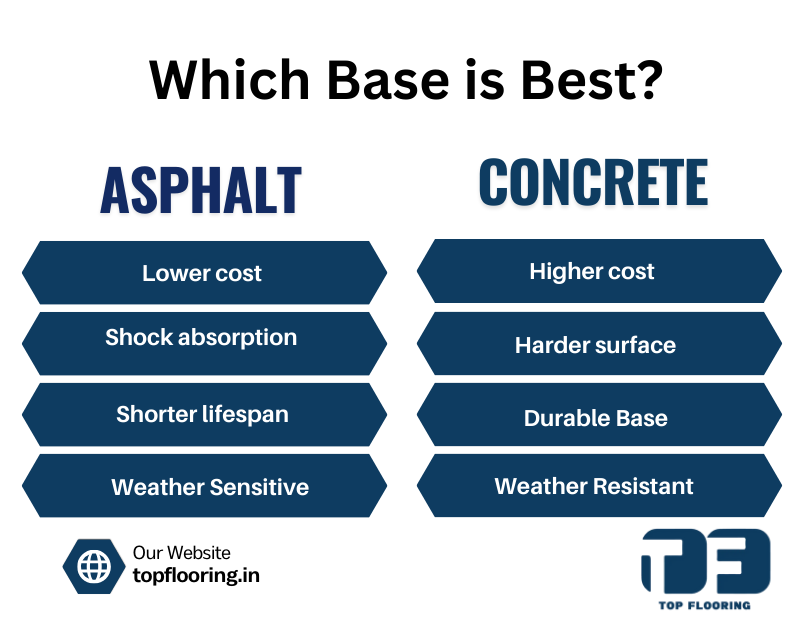
Asphalt vs Concrete: Performance & Cost Comparison
Here’s a quick side-by-side look at how the two options compare:
| Factor | Asphalt Base | Concrete Base |
| Initial Cost | Lower (Budget-friendly) | Higher (Premium investment) |
| Lifespan | 4–7 years | 5–10+ years |
| Shock Absorption | Softer on joints | Harder surface |
| Maintenance Needs | High (frequent crack repairs) | Low (occasional joint sealing) |
| Weather Resistance | Prone to heat & water damage | Stable in heat and rain |
| Time to Install | Faster | Slower (requires 30-day curing) |
| Suitability for Indian Climate | Fair (but heat-sensitive) | Excellent (heat and monsoon resistant) |
| Long-term Value | Moderate | High |
Why Choose Top Flooring?
When it comes to building a tennis court, choosing the right construction partner is as important as choosing the base material itself. That’s where Top Flooring stands out as one of India’s most trusted names in sports infrastructure. With years of experience in asphalt tennis court construction and concrete tennis court base construction across the country, Top Flooring combines technical expertise with knowledge of Indian climate challenges. From compact backyard courts to full-size ITF-compliant tournament arenas, the company has done hundreds of tennis court installations, each engineered for long-term strength, proper drainage and playability.
Top Flooring offers complete end-to-end solutions not just building strong foundations. But also finishing them with world-class acrylic tennis court construction systems. These multi-layer coatings include acrylic resurfacers, cushion coats and color coats. That turn a plain slab into a vibrant, professional-grade tennis hard court surface material. This ensures consistent ball bounce, excellent player grip and year-round durability even under Indian sun and monsoon. What sets Top Flooring apart is its transparent pricing. Whether you are trying to estimate the cost to build a tennis court in your backyard or evaluating the cost of building a tennis court for an academy. Our team gives you accurate, itemized quotes based on site analysis not generic figures so you can make informed decisions.
Top Flooring also has international quality certifications, uses ITF classified materials and maintains strict quality control throughout the project. With a strong nationwide network of trained installation teams and dealers. They ensure timely delivery and after-sales support across all India. Beyond construction, Top Flooring offers maintenance, resurfacing and repair services, so your investment continues to perform for decades. By choosing Top Flooring, you’re not just building a tennis court, you’re partnering with a team that’s committed to excellence, reliability and long term performance.
Which Tennis Court Base is Suitable For Indian Climate
When building a tennis court in India, one of the most important factors to consider is how well the base material can withstand the country’s harsh climate. India has intense UV radiation, high heat summer temperatures, heavy monsoon and shifting soil conditions all of which can put stress on the base layer of the tennis court. If the foundation is not strong enough to handle these challenges even the best acrylic top layers will fail, resulting in cracks, waterlogging and costly repairs.
Asphalt Courts in India
Asphalt tennis court construction is popular because it’s cost effective and quicker to install. But its flexibility, although good for shock absorption, is also its weakness under India’s extreme weather conditions.
- Heat in North India: In cities like Rajasthan, Delhi and Uttar Pradesh surface temperatures can touch 60°C during peak summer months.
- Monsoon Water Ingress: Indian monsoons are intense and often result in water logging on outdoor tennis courts.
- Soil Movement: Asphalt’s flexibility can’t resist this movement fully and often results in base settlement issues which reflect as surface swing on the playing area.
Regular crack filling and resurfacing a tennis court can extend the life of an asphalt tennis court but these repairs add to the long term cost of ownership.
Concrete Handles Indian Conditions Better
- Concrete tennis court base construction is far more resilient to India’s harsh weather and soil conditions. Its rigid structure and lower thermal expansion rate makes it more suitable for long term performance.
- Excellent Heat Resistance: Concrete doesn’t soften in high temperatures and stop surface warping and soft spots even in the hottest summer months.
- Water Resistance: Water can’t stab the dense surface easily and reduces the risk of damage, moisture swelling and surface peeling during monsoons.
- Stability: This helps the base to withstand soil heave, shrinkage and settlement and keeps the playing surface smooth and level for decades.
The Industry Shift Towards Concrete in India
Due to these advantages, there has been a visible shift in India’s sports sector. Many professional projects now prefer tennis hard court surface material systems built on concrete bases over asphalt. This trend is more pronounced in:
- Sports academies and coaching centers that host year-round tournaments and need durable, low-maintenance courts.
- Schools, universities and housing societies that want long lasting courts with minimal downtime for repairs.
- High rainfall cities like Kerala, Karnataka and North-East, where asphalt tennis courts get damaged within a few years of installation.
Though concrete is slightly more expensive, its ability to withstand India’s harsh UV, heat waves and monsoon floods makes it a far more reliable option for long term tennis facilities.
Which Option Is Best for You?
Choose Asphalt Tennis Court If
- You want a lower upfront budget: If your priority is to keep the initial investment low, asphalt is the better option. It costs less to install than concrete and is good for schools, housing societies or individuals building their first tennis court.
- You are building a private backyard tennis court: Asphalt is good for backyard or private tennis courts where play is occasional and light. These courts don’t face the wear of tournament level usage so asphalt’s shorter lifespan is not a concern.
- You can use regular maintenance and resurfacing: Asphalt bases need more maintenance over time, especially crack filling and surface patching every few years. If you can schedule regular maintenance and resurfacing, asphalt can be a practical option. With regular care, it can provide a smooth playing surface for over a decade.
Choose Concrete Tennis Court Base If
- You want long term savings: Concrete costs more upfront but pays off in the long run. With a life of 25-30 years or more, concrete bases require fewer structural repairs which means lower life time cost of ownership.
- The court used by schools, clubs or academies: For high traffic areas like schools, sports clubs and academies, concrete is the smarter choice. It can withstand daily play, coaching sessions and tournaments without deforming or cracking easily.
- Your area faces extreme heat or heavy monsoons: Concrete is better suited for India’s climate. If your area experiences extreme seasonal conditions, concrete will give you a more stable and reliable base.
- You want fewer structural issues over decades: Concrete courts have fewer surface cracks, settlement issues and deformation over time. Expansion joints control any movement, while the dense structure resists shifting soils.
Conclusion
The choice between asphalt and concrete tennis court flooring may seem like another technical decision on your project checklist but in reality it is one of the most important factors that will determine how your court performs, how safe it feels underfoot, how often it needs repairs and how long it will serve players before a rebuild is required. Think of the base as the backbone of your entire sports facility — if it is strong and stable everything else above it will last longer and perform better. Asphalt tennis court construction is chosen for its cost effective nature and faster installation timeline.
For schools, housing societies or private homeowners looking to add a recreational court quickly and economically, asphalt can be a good option. Its slightly softer structure offers natural shock absorption which many players find comfortable. But it comes with a trade off: asphalt surfaces are more prone to cracking and weather related damage which means they require more frequent maintenance cycles, resurfacing and crack repairs over the years. What looks economical in the beginning may cost more in the long run.
Although the cost to build a tennis court on a concrete base is higher, it often turns out to be more economical in the long run of the facility. Whatever route you choose, it’s essential to pair the base with a high quality acrylic tennis court construction system. This multi layer acrylic surfacing protects the base, improves ball bounce and traction, cushions player impact and gives the court its professional finish. Without this top system even the strongest base will not deliver the performance athletes expect from a tennis hard court surface material.
Frequently Asked Questions
Concrete handles heat, rain and soil movement better. Asphalt softens in summer and cracks in monsoons.
Acrylic sports flooring systems are applied over asphalt or concrete base to create the final tennis hard court surface material.
Yes. A backyard court is possible if you have enough space (at least 120×60 feet) and budget. The cost of a tennis court in the backyard varies with specifications but is lower than full size academy projects.
Concrete courts last 5–10 years and asphalt courts last 4–7 years with regular maintenance.
Tennis court cost including base, surfacing, fencing and lighting.



